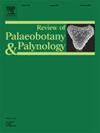Coniferous wood fossils as records of paleoecology, paleoclimatology, and paleoenvironment: A review
IF 1.7
3区 地球科学
Q2 PALEONTOLOGY
引用次数: 0
Abstract
Trees record a series of physiological responses to climatic and environmental changes within their wood. Consequently, quantitative and qualitative analyses of their tree growth rings enable the retrieval of past climatic and environmental information. Tree growth ring analyses have been extensively utilized in modern forestry, geography, paleoclimatology, and paleontology. This article aims to present the key proxies and anatomical characteristics that have proven valuable in various studies. Ten primary points of analysis are identified for fossil wood, including mean growth ring width, mean sensitivity, annual sensitivity, leaf life-span analysis, percentage of latewood, division of growth ring types, percentage diminution, identification of trauma signs, and solar influence, along with three different isotopes, carbon, oxygen and hydrogen, for mummified material. By examining these parameters and employing these methods on fossil conifer wood, we not only gain a unique perspective on leaf longevity and phenology but also develop a more comprehensive understanding of the paleoenvironmental and paleoclimatic conditions during the conifer's existence. Therefore, tree growth ring analyses offer distinct advantages for investigating fossil conifer wood and facilitating subsequent climatic and environmental reconstructions.
求助全文
约1分钟内获得全文
求助全文
来源期刊
CiteScore
3.50
自引率
21.10%
发文量
149
审稿时长
6 months
期刊介绍:
The Review of Palaeobotany and Palynology is an international journal for articles in all fields of palaeobotany and palynology dealing with all groups, ranging from marine palynomorphs to higher land plants. Original contributions and comprehensive review papers should appeal to an international audience. Typical topics include but are not restricted to systematics, evolution, palaeobiology, palaeoecology, biostratigraphy, biochronology, palaeoclimatology, paleogeography, taphonomy, palaeoenvironmental reconstructions, vegetation history, and practical applications of palaeobotany and palynology, e.g. in coal and petroleum geology and archaeology. The journal especially encourages the publication of articles in which palaeobotany and palynology are applied for solving fundamental geological and biological problems as well as innovative and interdisciplinary approaches.

 求助内容:
求助内容: 应助结果提醒方式:
应助结果提醒方式:


